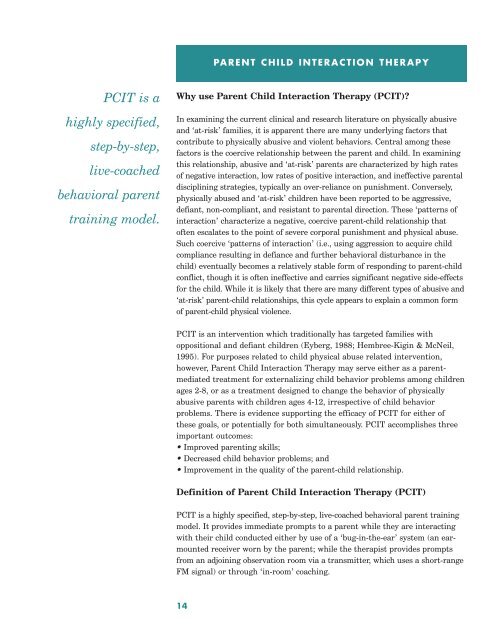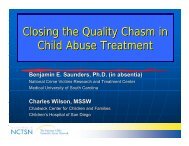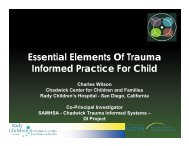Kauffman Best Practices Project Final Report - The Chadwick Center ...
Kauffman Best Practices Project Final Report - The Chadwick Center ...
Kauffman Best Practices Project Final Report - The Chadwick Center ...
Create successful ePaper yourself
Turn your PDF publications into a flip-book with our unique Google optimized e-Paper software.
PARENT CHILD INTERACTION THERAPY<br />
PCIT is a<br />
highly specified,<br />
step-by-step,<br />
live-coached<br />
behavioral parent<br />
training model.<br />
Why use Parent Child Interaction <strong>The</strong>rapy (PCIT)?<br />
In examining the current clinical and research literature on physically abusive<br />
and ‘at-risk’ families, it is apparent there are many underlying factors that<br />
contribute to physically abusive and violent behaviors. Central among these<br />
factors is the coercive relationship between the parent and child. In examining<br />
this relationship, abusive and ‘at-risk’ parents are characterized by high rates<br />
of negative interaction, low rates of positive interaction, and ineffective parental<br />
disciplining strategies, typically an over-reliance on punishment. Conversely,<br />
physically abused and ‘at-risk’ children have been reported to be aggressive,<br />
defiant, non-compliant, and resistant to parental direction. <strong>The</strong>se ‘patterns of<br />
interaction’ characterize a negative, coercive parent-child relationship that<br />
often escalates to the point of severe corporal punishment and physical abuse.<br />
Such coercive ‘patterns of interaction’ (i.e., using aggression to acquire child<br />
compliance resulting in defiance and further behavioral disturbance in the<br />
child) eventually becomes a relatively stable form of responding to parent-child<br />
conflict, though it is often ineffective and carries significant negative side-effects<br />
for the child. While it is likely that there are many different types of abusive and<br />
‘at-risk’ parent-child relationships, this cycle appears to explain a common form<br />
of parent-child physical violence.<br />
PCIT is an intervention which traditionally has targeted families with<br />
oppositional and defiant children (Eyberg, 1988; Hembree-Kigin & McNeil,<br />
1995). For purposes related to child physical abuse related intervention,<br />
however, Parent Child Interaction <strong>The</strong>rapy may serve either as a parentmediated<br />
treatment for externalizing child behavior problems among children<br />
ages 2-8, or as a treatment designed to change the behavior of physically<br />
abusive parents with children ages 4-12, irrespective of child behavior<br />
problems. <strong>The</strong>re is evidence supporting the efficacy of PCIT for either of<br />
these goals, or potentially for both simultaneously. PCIT accomplishes three<br />
important outcomes:<br />
• Improved parenting skills;<br />
• Decreased child behavior problems; and<br />
• Improvement in the quality of the parent-child relationship.<br />
Definition of Parent Child Interaction <strong>The</strong>rapy (PCIT)<br />
PCIT is a highly specified, step-by-step, live-coached behavioral parent training<br />
model. It provides immediate prompts to a parent while they are interacting<br />
with their child conducted either by use of a ‘bug-in-the-ear’ system (an earmounted<br />
receiver worn by the parent; while the therapist provides prompts<br />
from an adjoining observation room via a transmitter, which uses a short-range<br />
FM signal) or through ‘in-room’ coaching.<br />
14






